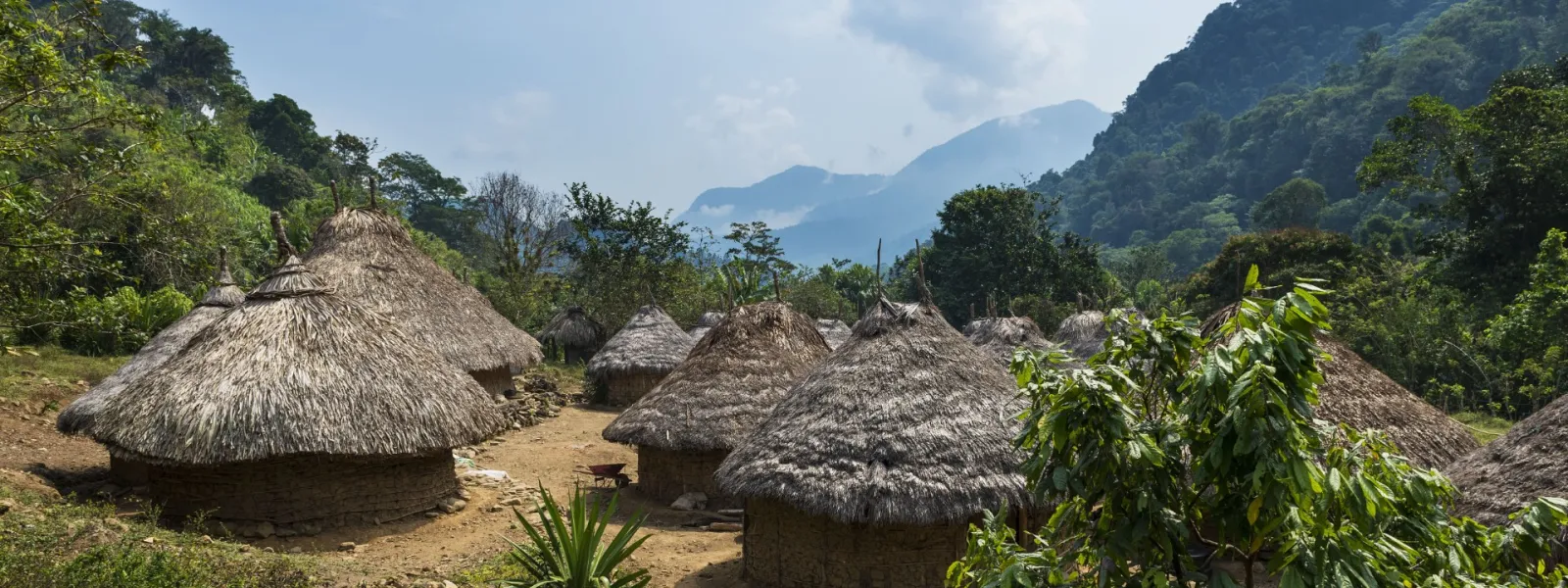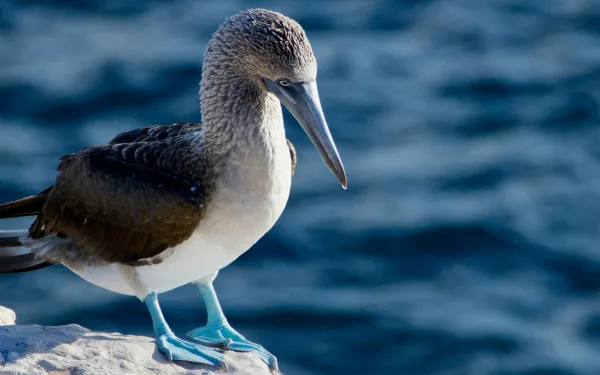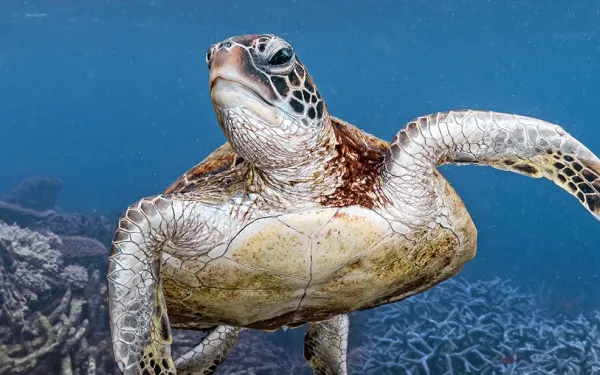
Project
Preserving the legacy of the Sierra Nevada de Santa Marta, Heart of the World
Rising abruptly from Colombia’s Caribbean coast, the Sierra Nevada de Santa Marta reaches 5,775 meters (18,946 ft.) at its highest points, the peaks of Bolívar and Colón. It is the highest coastal mountain system in the world, a place where indigenous knowledge and nature’s own wisdom converge.
The sheer changes in elevation create a wide variety of ecosystems within a small area, where the diversity of plant and animal life creates a unique exuberant region. The melting snows of the highest peaks form rivers and lakes, whose freshwater flows down steep slopes to the tropical sea at the base of the mountains.
The indigenous Arhuaco, Kogi, Wiwa, and Kankuamo people protect and care for this natural treasure with an authority they have inherited from their ancestors. According to their worldview the land is sacred and shared in divine communion between humans, animals, plants, rivers, mountains, and the spirts of their ancestors.
Despite this ancestral inheritance, development projects proposed for the region have failed to take the opinions of these indigenous groups into consideration. The Sierra Nevada de Santa Marta is currently threatened by 251 mineral concessions, hydroelectric projects, agriculture, urban sprawl, and infrastructure projects.
Many of these concessions were granted without the prior consultation of the indigenous communities, which represents a persistent and systematic violation of their rights.
Mining, which implies the contamination and erosion of watersheds, threatens the health of more than 30 rivers that flow out of the Sierra; these are the water sources of the departments of Magdalena, César, and La Guajira.
These threats have brought this natural paradise to the brink of no return. With it, would go the traditional lives of its indigenous inhabitants, who are dependent on the health of their land and the sacred sites it contains.
The Sierra hosts the archaeological site of la Ciudad Perdida, the Lost City, known as Teyuna, the cradle of Tayrona civilization. According to tradition, it is the source from which all nature was born—the living heart of the world.
The four guardian cultures of the Sierra are uninterested in allowing this natural and cultural legacy to disappear.

Related projects

10 environmental news stories to end 2025 on a hopeful note
We are nearing the end of a complex year, and taking stock seems daunting. Multilateralism is faltering as environmental crises worsen and urgently demand decisive action.In such turbulent times, it is worth taking stock of what we, as humanity, have achieved in building a more just and sustainable world for all who inhabit it.2025 will be remembered as the year when an underwater expedition thrilled us in real time, when we celebrated the implementation of agreements to protect life in the ocean, and when international court rulings transformed the pursuit of justice to protect people and the environment from the climate emergency.These are some of the environmental victories that this year has left us with, and they deserve to be celebrated, just as we honor the fire that shines in the darkness. Because even with small lights, we can continue to illuminate a path of hope toward environmental and climate justice. 1. International courts issued landmark decisions for climate justiceThe Inter-American Court of Human Rights and the International Court of Justice released their respective advisory opinions on the climate emergency. Both decisions clarified the obligations of states to protect the rights of people and nature in the face of the climate crisis.These decisions are part of an unprecedented global movement for climate justice, which also includes the advisory opinion issued in 2024 by the International Tribunal for the Law of the Sea and similar future decisions, such as the one expected from the African Court on Human and Peoples' Rights.Learn More: Dialogue Earth 2. Climate litigation exceeded 3,000 cases worldwideClimate litigation reached 3,099 cases worldwide, according to a report by the Sabin Center for Climate Change Law and the United Nations Environment Program. Although climate litigation in countries in the global south is still in the minority (9.8% of the total documented), it has grown steadily. Brazil stands out as the third country with the most cases in the world (135), and other Latin American countries (Mexico, Colombia, Argentina, and Chile) are among the top 15 with the most cases reported.This growth demonstrates the increasing use of strategic litigation to promote concrete action on the causes and consequences of the climate crisis.Learn More: Sabin Center for Climate Change Law 3. Colombia declared its part of the Amazon free from oil and large-scale mining activitiesDuring the 30th UN Climate Change Conference (COP30), Colombia declared the entire Colombian Amazon region a zone free from oil and large-scale mining activities, announcing it as a "reserve zone for renewable natural resources."The decision implies an unprecedented limitation on the expansion of mining and hydrocarbon activities in more than 48 million hectares, equivalent to 7% of the entire Amazon region. It is also a call to other Amazonian countries to follow suit.Learn More: InfoAmazonia 4. Countries create a global mechanism to promote a just energy transitionAn important step forward at COP30 was the adoption of the Belém Action Mechanism, created within the framework of the Just Transition Work Program.The mechanism will function as a coordinating space to centralize global initiatives, offer technical assistance, and strengthen international cooperation. It is an achievement driven by civil society to promote ambitious climate action and a transition that does not repeat the mistakes of the fossil fuel era.Learn More: AIDA and The Climate Reality Project América Latina 5. An underwater expedition in Argentina marked a scientific and technological milestoneThe expedition "Underwater Odel Plata Canyon: Talud Continental IV," led by scientists from Argentina's National Scientific and Technical Research Council, in collaboration with the Schmidt Ocean Institute, explored the deep ocean in the Mar del Plata submarine canyon for 21 days, while broadcasting live on YouTube and Twitch.The result: 40 new marine species and an unexpected diversity of cold-water corals were discovered, findings that were seen and celebrated in real time by millions of people.Learn More: CONICET 6. The High Seas Treaty will finally enter into forceIn a process that took more than two decades, the High Seas Treaty this year reached the 60 ratifications needed to trigger its entry into force, which will occur on January 17, 2026. This binding agreement allows for the protection of the part of the ocean outside of national boundaries, almost half of the planet, through the creation of marine protected areas in international waters and the conduct of environmental impact assessments of planned human activities on the high seas. This is a historic milestone for the protection of the ocean and the well-being of millions of people in Latin America and around the world.Learn More: AIDA 7. Implementation begins on agreement ending harmful fisheries subsidiesThe World Trade Organization's Agreement on Fisheries Subsidies came into force in September this year. It is the first multilateral trade treaty to prioritize environmental sustainability, as well as a milestone in ensuring food security and the livelihoods of coastal communities.The agreement prohibits government subsidies that promote illegal fishing and the depletion of overexploited stocks.Learn More: WTO 8. Green sea turtles are no longer considered an endangered speciesAfter decades of decline, the population of green sea turtles is recovering. The International Union for Conservation of Nature no longer considers them endangered and has reclassified them as a "species of least concern."This sea turtle population has increased thanks to decades of conservation work to protect nesting areas, reduce capture, and prevent bycatch. AIDA was part of these efforts, protecting them in the 1990s from hunting—which was legal at the time—in Costa Rica.Learn More: AIDA and IUCN Red List 9. Protection of key ecosystems around the world, including the Galapagos, is growingUNESCO added 26 new biosphere reserves in 21 countries, the highest number in 20 years, and approved the expansion of 60,000 square kilometers in the Galapagos Biosphere Reserve in Ecuador to incorporate the Hermandad Marine Reserve. This will protect the area where dozens of marine species, many of them protected, transit, and which is considered one of the most diverse ocean corridors in the world.Learn More: LaderaSur and Government of Ecuador 10. Deforestation decreased in Afro-descendant territories in Latin AmericaAfro-descendant communities in Brazil, Colombia, Ecuador, and Suriname have significantly reduced their deforestation rates, according to new research from Conservation International.The study showed that Afro-descendant communities are critical to environmental conservation, as 56% of their lands are located in the 5% of the world with the highest biodiversity.Learn More: Conservation International
Read more
Our Contribution to Environmental Justice in 2025
At AIDA, one of our core pillars is using the law strategically — backed by science and international advocacy — to set important precedents that protect the environment and human rights across Latin America.This year, our work helped strengthen both regional and global legal frameworks so they can better respond to the social and environmental challenges we face today.These advances led to the creation of key legal tools that open new opportunities to defend communities and their territories, protect the region’s biodiversity, and hold governments and companies accountable.The progress we saw in 2025 highlights the transformative power of law, science, and the collective strength of communities when they work together. 1. Two new global treaties restore hope for the ocean — and for all of usThis year brought two historic achievements that could change the future of the ocean, and our own.The first is the ratification of the High Seas Treaty, which will take effect in January 2026. This legally binding agreement creates shared rules and a system of multilateral governance for the ocean areas beyond national jurisdiction — nearly half the planet.The second milestone is the entry into force of the World Trade Organization’s Agreement on Fisheries Subsidies. For the first time, a multilateral trade treaty puts environmental sustainability front and center by banning government subsidies that fuel illegal fishing and the depletion of overfished stocks.AIDA played an important role in ensuring Latin America’s perspectives were reflected in both agreements. We provided technical support to government representatives throughout the process, and we continue working to make sure these treaties lead to real, effective action across the region.Learn More 2. Maya community in Guatemala achieves a landmark environmental victoryIn Chinautla, Guatemala, the Poqomam Maya community won an unprecedented court ruling over decades of river pollution that violated their rights. The court ordered the municipality to carry out studies, programs, and plans to reduce pollution — and to ensure the community is involved every step of the way.This is the first time a court in Guatemala has recognized both a people’s right to a healthy environment and their central role in finding solutions. The ruling could inspire other municipalities along the Motagua River, the country’s longest river, where pollution also threatens the Mesoamerican Reef.Beyond providing legal support, AIDA helped the community document illegal dumping that harmed their water sources. This hands-on “community science” effort played a crucial role in both the lawsuit and the historic ruling.Learn More 3. Corte Interamericana marca un antes y después para la justicia climáticaOn July 3, the Inter-American Court of Human Rights issued its long-awaited Advisory Opinion 32 on human rights and the climate emergency — a landmark moment for climate justice both regionally and globally. The Court clarifies the legal obligations of states to protect people and communities affected by the climate crisis, opening new pathways for justice in national and international courts, climate negotiations, and public policy advocacy.For the first time, the Court recognized the right to a healthy climate and affirmed that states have a duty to prevent companies from violating human rights in the context of climate change.Ahead of this decision, AIDA helped amplify the voices of communities across the region, facilitating their testimony before the Court and presenting our own arguments for recognizing the right to a stable and safe climate.Learn More Discover the stories behind these victories and our full review of the year in our 2025 Annual Report.
Read more
COP30 ends — with a few achievements to move forward
With more than 25 hours of delay, the 30th UN Climate Change Conference (COP30) has come to an end. The so-called "Amazon COP," held in the Brazilian city of Belém do Pará, leaves behind disappointment for failing to change course, but also some advances that can help push climate action forward. It was not a total failure: multilateralism remains intact, though battered.COP30 was marked by the presence of Indigenous peoples, especially from the Amazon basin, who filled the streets and side events. However, according to reports, only a fraction of these delegations gained access to the formal negotiation rooms, while a disproportionate number of representatives from the fossil fuel industry participated in the official event. This imbalance reflects the democratic health of the climate regime: at the Amazon COP, the power of Indigenous and Afro-descendant peoples was felt in the streets, but their voices remained underrepresented in decision-making spaces.A few days into the conference, the latest synthesis report of updated nationally determined contributions was released. Its message was more bitter than sweet, but it offered one important takeaway: although the gap to keep global warming below 1.5°C remains enormous and complex, the report confirms that the Paris Agreement has indeed helped steer the challenge. We are in a better position than in a scenario without the agreement: projected emissions growth has been slowed, though not nearly enough.At this point, it is clear that COPs will not "save the world," but it also seems impossible to overcome this crisis without the cooperative platform they provide. From that perspective, it is worth asking what COP30 leaves us. The approved agreement: Global MutirãoThe word "Mutirão" references the spirit of collective effort—body and soul—that Brazil sought to bring to the international negotiation process at this COP.The approved agreement reiterates the goal of keeping the planet’s temperature increase below 1.5°C, acknowledging that time is running out. To that end, it proposes two voluntary mechanisms, led by the Presidency, which for now seem more like statements of good intent than tools with teeth: a "Global Implementation Accelerator" and the "Belém Mission for 1.5°C."On financing, the text establishes a two-year work program on Article 9.1 of the Paris Agreement, which concerns the public resources developed countries must provide, understood in the context of Article 9 as a whole.A footnote was added to clarify that this does not prejudge the implementation of the new global goal. Civil society organizations warn that this formulation risks further diluting developed countries’ specific obligations under the narrative of "all sources of financing," without clear rules on who must actually provide the resources and under what conditions. The real value of all this remains to be seen in practice. What was gained: A new mechanism for a just transitionA major achievement of COP30 was the adoption of the Belém Action Mechanism (BAM), a new institutional arrangement under the Just Transition Work Programme. It was the main banner carried by organized civil society.The mechanism is designed as a hub to centralize and coordinate just transition initiatives around the world, providing technical assistance and international cooperation to ensure the transition does not repeat the mistakes of the fossil era.The text incorporates many of the principles championed by Latin American civil society—including human rights, environmental and labor protections, free, prior and informed consent, and the inclusion of marginalized groups—as essential elements for achieving ambitious climate action.Even with gaps in safeguards and governance definitions, the BAM is a concrete step forward for this COP on climate justice. It creates a starting point to discuss not only whether there will be a transition, but how it will be done and under what rules, so as not to replicate the logic of the fossil economy. Its design and implementation will be debated at upcoming COPs, where it will be crucial for the region to arrive with solid, united proposals. Ending fossil fuels and deforestation: Two “almosts” that move us forwardAn agreement to leave behind fossil fuels and end deforestation—directly addressing the main drivers of the climate crisis—"almost" made it into the final decision.More than 80 countries from both the global north and south called for a roadmap to exit oil, gas, and coal. More than 90 supported a roadmap to stop and reverse deforestation by 2030. Although these requests made their way into drafts of the closing decision, they disappeared from the final text after resistance from major fossil fuel producers.Still, we do not leave empty-handed: Brazil, as COP30 Presidency, announced it will advance these roadmaps outside the formal framework of the UNFCCC. For the fossil fuel phaseout, Colombia committed to co-organize, with the Netherlands, the first global conference on the topic in April 2026.Although these items were not secured within the official negotiations, it is worth celebrating that—for the first time—such a broad coalition of countries united to achieve them. These two "almosts" matter: they set a new political and legal baseline for the rounds ahead. Two tools to advance adaptationCOP30 delivered tools to keep adaptation negotiations moving forward.The Mutirão decision calls for tripling collective adaptation finance by 2035, tied to the $300 billion USD per year agreed under the new global goal. This falls short of what the poorest countries asked for (tripling by 2030, with an explicit figure) and lacks clarity or guarantees regarding the role of developed countries. But it is a political anchor worth building on.At the same time, a first package of 59 indicators was adopted for the Global Goal on Adaptation (GGA). Several African countries and experts described them as "unclear, impossible to measure, and in many cases unusable," because they sacrifice precision and grounding in community realities in order to unblock the agreement. In response, the text included the "Belém–Addis Vision," a two-year window to correct flaws and make the framework operational by 2027.In short, we have more promises of money and an indicator framework weaker than necessary, but also a process through which the region can continue pushing for a useful GGA and for fair, sufficient adaptation finance. Loss and damage: Slow and uncertainProgress on this issue has been painfully slow compared with the urgency of the problem. At COP30, the third review of the Warsaw International Mechanism was finally approved. The result is frustrating: discussions have taken a decade while communities are already paying the cost of warming.On the other hand, the Loss and Damage Response Fund, created two years ago, issued its first call for proposals, with an initial package of $250 million USD in grants available over the next six months. The Fund has $790 million USD pledged, but only $397 million USD actually deposited—an enormous gap compared to the hundreds of billions estimated annually for developing countries.The expected political pressure for developed countries to scale up contributions was largely diluted in the final text, although the Fund was at least linked to the new global financing goal agreed at COP29. A new Gender Action PlanCOP30 concluded with the adoption of a new Gender Action Plan under the renewed Lima Work Programme. The Plan identifies five priority areas: capacity-building and knowledge; women’s participation and leadership; coherence among processes; gender-responsive implementation and means of implementation; and monitoring and reporting. It also provides a roadmap to ensure climate action is truly gender-responsive, with indicators to track progress. Methane: A super-pollutant still lacking the spotlight science demandsAt COP30, short-lived climate pollutants—especially methane—gained visibility thanks to a dedicated pavilion and dialogues with regional and global actors. The Global Methane Status Report 2025 was also presented, noting “significant” progress since the 2021 launch of the Global Methane Pledge. However, it warns that current progress remains far from the goal of reducing methane emissions by 30% by 2030.In the official negotiations, the draft of the Sharm el-Sheikh Mitigation Ambition and Implementation Work Programme included an explicit reference to methane mitigation through proper waste management, but that mention was removed from the final text, leaving only a general call to improve waste management and diminishing the focus on the urgent need to reduce emissions of a pollutant whose mitigation is essential to achieving the Paris Agreement goals. Still, during COP30, the global “No Organic Waste (NOW) Plan to Accelerate Solutions” was launched, aiming to reduce methane emissions from organic waste by 30% by 2030.Overall, this COP missed a crucial opportunity to advance its core objective. If we truly want to stay on track with the Paris Agreement, we must treat methane as what it is: a decisive opportunity we are still not seizing. How we close COP30 and prepare for the nextCOP31 will be held in Turkey, under the presidency of Australia. And despite the shortcomings of COP30, there are at least four things to defend and build on:The normalization of the debate on phasing out fossil fuels, with more than 80 countries openly calling for a roadmap and Colombia–Netherlands taking that discussion to a dedicated conference in 2026.A forest agenda that, although left out of the text, carries the promise of a Brazilian roadmap and explicit support from a wide group of countries.A small but real advance on adaptation, with the decision to triple finance and a first set of indicators that, while weak, offer a basis to push for improvements.The creation of a new mechanism for a just transition, which can shape how the transition unfolds—bringing together and strengthening efforts that support and protect workers, communities, and Indigenous peoples.
Read more